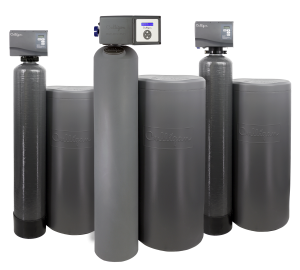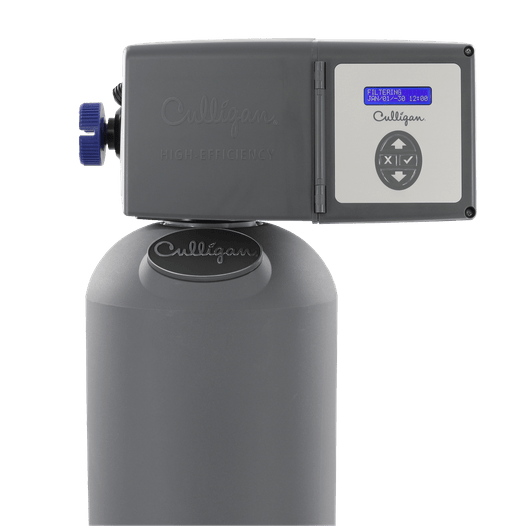Iron/Rusty Stains In Your Home
If you’ve noticed yellow water, brown stains, or a metallic taste from your taps, you’re not alone. Across the U.S., many households encounter signs of iron contamination in their water supply—especially in areas with older plumbing systems or private wells. While iron is a naturally occurring mineral essential to human health in small amounts, elevated levels can lead to discolored water, plumbing damage, and potential health concerns.
Let’s break down how iron enters your water, the risks it presents, and how professional water treatment can help restore clean, fresh-tasting water in your home.

Four Types Of Iron
Understanding the different forms of iron and how they behave in water is essential for selecting the right treatment method:
1. Ferric Iron (Red Iron)
This oxidized, insoluble form is visible in water as a reddish or orange tint and is commonly responsible for rust stains on sinks, bathtubs, and laundry. Iron filters—such as Culligan’s Iron-Cleer® system—are specifically engineered to remove ferric iron particles.
2. Ferrous Iron (Clear Water Iron)
Dissolved and colorless when it leaves the tap, ferrous iron oxidizes upon exposure to air, turning reddish-brown. This type is often found in groundwater and is commonly treated using water softeners with ion exchange technology.
3. Organic Iron
This form develops when iron bonds with organic matter, such as tannins from decaying vegetation. It often causes dark water and black residue. Treating organic iron requires a specialized filtration system designed to handle both the iron and the organic compounds.
4. Iron Bacteria
These microorganisms feed on iron and create slimy, dark-colored buildup in toilet tanks and pipes. They can also produce foul odors and metallic-tasting water. While chemical shock treatment can temporarily address the issue, long-term control requires reducing iron levels in the water supply.
What Causes Rusty or Discolored Water?
Whether you rely on a public water system or a private well, iron can enter your water supply through a variety of sources:
- Corroded iron or galvanized steel pipes in older homes and buildings
- Naturally iron-rich soil and rock formations surrounding groundwater sources
- Iron bacteria buildup inside plumbing systems
- Aging hot water heaters that accumulate rust and sediment
- Municipal line flushing or water main repairs that stir up settled sediment
- Leaching of iron or rust from deteriorating fittings, valves, or faucet components
In some cases, discoloration may be localized to a single faucet or may affect both hot and cold water depending on the plumbing layout.
How Iron Enters Private Well Water
If your home relies on a private well, iron contamination is a common issue, especially in regions with mineral-rich soil. Iron can infiltrate your water supply through:
- Erosion of naturally occurring iron deposits underground
- Corrosion of iron pipes, pump components, or well casings
- Surface runoff from agricultural activity or disturbed land
- Groundwater drawing in iron-rich materials from surrounding formations
- Favorable conditions for iron bacteria growth in the well environment
Well owners should test their water regularly, as iron often appears alongside other common well contaminants like manganese or hydrogen sulfide.
Common Water Quality Problems Caused by Iron
Iron in water isn’t just a cosmetic nuisance—it can affect your home’s plumbing and water-using appliances over time:
1. Rust Stains
Ferric iron causes visible staining in toilets, sinks, tubs, and on clothing. These rust-colored marks often require harsh cleaners to remove and can degrade bathroom and kitchen surfaces.
2. Cloudy or Murky Water
Discoloration or turbidity may result from oxidized iron, sediment, or bacterial growth. This cloudy water can reduce confidence in your water’s safety and cleanliness.
3. Metallic Taste or Odor
A bitter or metallic taste in your drinking water often indicates iron or other metal contamination, especially if your water system includes aging pipes or fixtures.
4. Slime and Biofilm
Iron bacteria produce a gelatinous buildup inside plumbing systems and can leave an oily film on water or reddish deposits in toilet tanks. These bacteria may also worsen odors and impact water clarity.
Is Iron in Water a Health Concern?
Iron is considered a secondary contaminant by the U.S. Environmental Protection Agency (EPA), meaning it affects water aesthetics (taste, color, and smell) rather than posing an immediate health risk. The EPA’s recommended limit for iron in drinking water is 0.3 mg/L.
However, indirect risks may occur when high iron levels interact with other water contaminants or in sensitive populations, including:
- Pregnant individuals
- Infants and young children
- People with hemochromatosis (iron overload disorder)
- Individuals with weakened immune systems
Regular water testing is the best way to determine whether iron levels or other contaminants are affecting your home’s water quality.
Iron Removal and Water Treatment Options
Culligan offers a wide range of treatment solutions tailored to different forms and levels of iron contamination:
Water Softeners
Culligan high-efficiency water softeners remove ferrous (clear) iron and hardness minerals through ion exchange, helping prevent scale buildup and corrosion.
Water Filters
Water filtration systems can remove iron particles, rust, and sediment, improving water clarity and protecting your plumbing system from long-term damage.
Water Testing by Culligan
Professional water testing is essential to identifying your exact contamination level and determining the best treatment system. Culligan offers lab-tested results and expert recommendations based on your home’s needs.
Solutions
Suggested Products

Aquasential™ Smart High Efficiency Water Softener
- Smart brine tank auto-monitors salt levels
- Convenient auto-bypass valve
- Reliable non-corrosive valve
- Worry-free maintenance

Aquasential™ Smart High Efficiency Whole House Water Filters
Reduce sediments in your water and contaminants that cause your water to appear, taste, and smell unpleasant. Your system can also lessen the taste and odor of chlorine, and prevent pipe damage and staining from low pH water. Additional customizations include:
- Culligan® Filtr-Cleer® Water Filters – Reduces Sediment Problems
- Culligan® Cullar® Water Filters – Reduces Taste and Odor Problems
- Culligan® Cullneu Water Filters – Reduces Acid Problems

Facebook